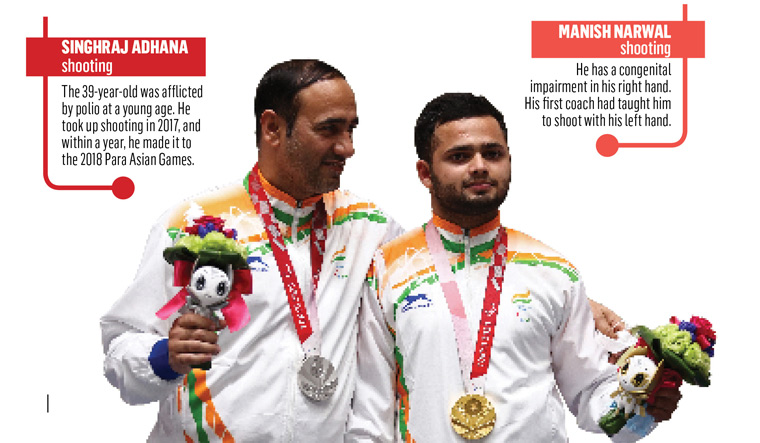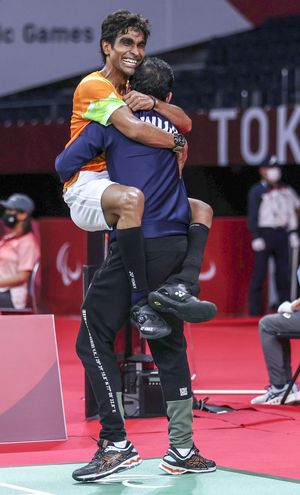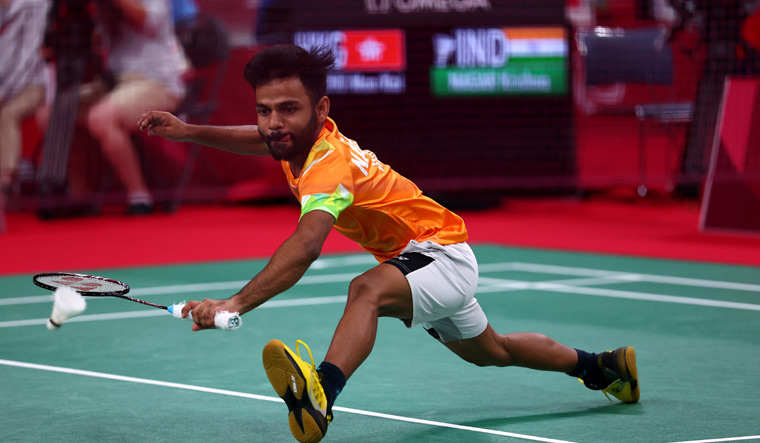Yogesh Kathuniya had shut himself in his bedroom on returning home from Tokyo. With a silver medal in discus throw F-56 (seated position) in hand, he landed in Delhi into a whirlwind of receptions. He had finally managed to get some shut-eye on reaching his home in Bahadurgarh, Haryana. He spoke to THE WEEK, bleary-eyed but wearing a wide grin, the sense of achievement having finally sunk in. The 24-year-old son of an Army officer suffers from Guillain-Barre syndrome, a neurological disorder that eventually led to paraplegia. At the Paralympics, a throw of 44.38m in his last attempt won him the silver medal.
Kathuniya is one among the 17 Indian Paralympians who contributed to a national record haul of 19 medals—five gold, eight silver and six bronze—at the Games. Before Tokyo, India had a total of 12 medals from all its previous Paralympics appearances combined, resulting in the euphoria on the return of these champions.
At the Kathuniya household, the medallist’s mother, Meena Devi, understands what it means for her son to make it to the podium. When he was a young boy, Devi would strap him to her scooter as she took him for physiotherapy sessions. To her, after all the hardship, this silver is as good as gold. “Life has changed drastically since I won in Tokyo,” said Kathuniya. “People recognise me now. Those who used to say I could not do it are now congratulating me.” The BCom graduate from Delhi University wants to specialise in sports management.
Meanwhile, Noida district magistrate Suhas Lalinakere Yathiraj became the first IAS officer to win a medal at the Olympics or Paralympics. In 2019, the badminton player was posted in Lucknow and was training with coach Gaurav Khanna for the Paralympics when he was transferred to Noida as district magistrate. When Covid-19 struck, badminton took a back seat as he had to deal with lockdowns and other issues. He would train early in the day or late at night. He would find sparring partners to train with and Khanna would share his analysis through video calls. In the final of the men’s singles SL-4 category (for a congenital deformity in his leg), Yathiraj bagged the silver after losing to world No 1 Lucas Mazur of France. “During Covid [lockdowns], I could not practise enough. But once things reopened and as the Games drew near, I practised well. It is not how many hours you spend in training but what you do during it that is important,” said the 38-year-old from Karnataka. He received a rousing reception on his arrival. “I would like to be recognised as a good human being who helped at least one person in his life,” he said.
Khanna, who was instrumental in Yathiraj’s performance, is the national para-badminton coach and runs the Gaurav Khanna Excellia Badminton Academy (GKEBA) in Lucknow, India’s first professional para-badminton academy. Besides Yathiraj, his wards Pramod Bhagat (men’s singles SL-3), Krishna Nagar (men’s singles SH-6) and Manoj Sarkar (men’s singles SL-3) also won two golds and a bronze, respectively. The bond between him and his wards was made evident when both Bhagat and Nagar jumped into Khanna’s arms on court after their respective medal-clinching matches. “I am super happy for the gold medals we got and happy, too, for the rest who did not,” he told THE WEEK from Tokyo. “I had promised Deepa ma’am (Paralympic Committee of India president Deepa Malik) five medals; we got four.”
Khanna started his academy in 2019, ahead of badminton making its debut at the Paralympics in Tokyo. Khanna, who has also worked with the deaf badminton players, has considerable experience coaching players with disabilities. “Bhagat was already the Asian and World champion. The only thing left for him was to win a Paralympic medal,” said Khanna. “He is our strongest player. In the last two years, we have worked on his strength, speed and stamina.”
On his other golden boy, Nagar, who has short stature impairment, Khanna said, “The idea was to overcome the issue of reach by working on his strength and speed.” Nagar, who hails from Jaipur, took up badminton at 14. The 4’ 3” Nagar joined GKEBA in 2019. The academy boasts of four state-of-the-art badminton courts, world-class gymnasium, sauna, Jacuzzi and hostel facilities.
Shooting, too, delivered multiple medals for India. While Avani Lekhara was the toast of the town, winning a gold and a bronze, Manish Narwal, who turns 20 in October, is also quite the star. He has a congenital impairment in his right hand, but the young pistol shooter won the gold medal in the mixed 50m SH-1 event, setting a Paralympic record of 218.2. Shooting was a hobby for him, but he participated in the India trials for the 2017 Bangkok World Cup, and was picked. His rise from there was consistent. His first coach had taught him to shoot with his left hand. The hard work paid off in Tokyo, where he pipped senior teammate Singhraj Adhana, who won silver in the same event. Both are from Faridabad in Haryana.
For Adhana, the silver was his second medal at Tokyo, having won bronze earlier in the men’s 10m air pistol SH-1 class. The 39-year-old, who was afflicted by polio at a young age, hails from a farming family and took to shooting while chaperoning his two kids and nephew to a shooting range in 2017. Within a year of taking up the sport, he made the cut for the 2018 Para Asian Games and since then has competed in numerous international competitions. “I contracted polio when I was one. There were no polio drops in the village. But my parents and grandmother did not give up. I used to walk with a stick and my mother would always say I had to trust in myself to walk on my feet. By the grace of God, I stopped using the stick when I was 14-15. Vishwas ki jeet thi (It was a victory of belief),” he said after the medal win.
For PCI president Malik, a former Paralympic medallist, the Tokyo Games was a watershed moment in the Paralympic movement in India. Speaking to THE WEEK about the change that has come about, a beaming Malik said, “It is all courtesy of beautiful coordination between government (Sports Authority of India and Target Olympic Podium Scheme), federations, coaches and athletes. Plus, right amount of funding for equipment and prosthetics. The coaches, too, are training and upgrading themselves. Most importantly, timely help is given.” Malik takes pride in the quick interventions by the PCI. For instance, emails from players or coaches do not sit in the PCI inbox for long; quick correspondence between key stakeholders has helped immensely.
With the Paris Paralympics just three years away, Malik is already preparing for the challenges that would arise. “My challenge is to get athletes to qualify early; most do so towards the end. Ten to fifteen athletes get aid from TOPS, and only for two or three months before the Games,” she said. Malik suggests that TOPS start with B-level para athletes. “A-level athletes are the top-ranked ones who would have already qualified, but [a focus on] B-level athletes is a must so that they get their prosthetics and equipment early.” While Malik has praised the system in place with SAI and the Union sports ministry, she also wants the states to be more proactive.
The attention that the Tokyo Paralympics has received has pleased the community. Its mainstreaming—primarily due to broadcasting and media coverage—is a crucial development in India. Malik acknowledges this and says a shift is happening, but she also wants “coaches to take para sports more seriously”. While there is no paucity of talent, the key to India’s para athletes succeeding would be to have more coaches like Gaurav Khanna.





